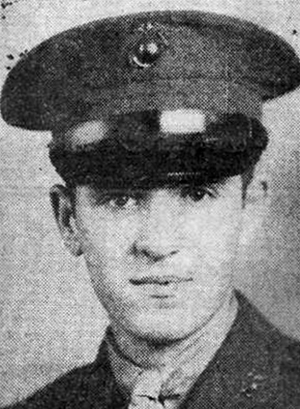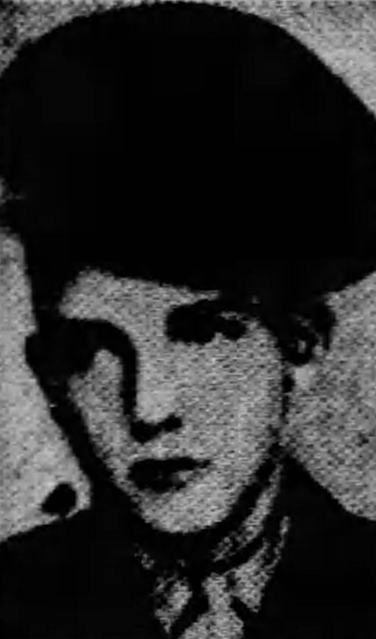Henry Irvin Starks

Private Henry I. “Irvin” Starks was a Marine Corps gunner who flew with VMSB-241.
He was killed in action at the battle of Midway on 4 June 1942.
Branch
Marine Corps Regular
Service Number 324422
Current Status
Remains not recovered.
Pursuit Category
Based on circumstances of loss, this individual is considered permanently non-recoverable.
History
Henry Irvin Starks III was born on 9 September 1923 to Henry and Velma Gladys (Hickman) Starks of Springfield, Illinois. He spent his first few years in Springfield, but tragedy marred his youth; on the last day of December 1928, the elder Henry Starks died of tuberculosis at the age of twenty-eight. The children (Irvin and younger sister Dorothy) were taken in by their Starks grandparents and lived in Decatur until 1937, at which point they moved back to Springfield and settled at 1109 South 11th Street. Irvin enrolled at Feitshan’s High School, and graduated with his diploma with the class of 1941.[1]
Starks joined the Marine Corps in the first fall of his adult life; he reported for active duty on on September 30, 1941, shortly after his 18th birthday. After completing boot camp at MCRD San Diego, Starks was chosen for additional training in aviation maintenance and reported to Aircraft Engineering Squadron 22 shortly before the attack on Pearl Harbor.
Private Starks served with the engineering squadron for the first several months of the war before being transferred to the Second Marine Aircraft Wing (MAW-2) in April 1942. There, he met and befriended another young private from Chicago named Teman Wilhite. Starks and Wilhite both boarded the USS J. Franklin Bell in early May of 1942 for transit to Pearl Harbor; after spending less than a week in the Territory of Hawaii, the young Marines received further orders–they would join the forward echelon of MAW-2, stationed at remote Midway island.
The USS Kitty Hawk deposited her passengers and cargo at Midway’s Eastern Island on May 26, 1942. The new Marines, including Starks and Wilhite, were counted off and assigned to duty with Major Lofton Henderson‘s VMSB-241; the veteran pilots and crew, however, were more interested in the nineteen new Douglas Dauntless SBD-2 dive bombers that also arrived on the Kitty Hawk. If Starks hoped to tinker with one of the Dauntlesses, he was quickly disappointed. Almost all of the newer men were assigned to a separate section of the squadron, and looked with dismay at their mounts: an assortment of obsolete Vought SB2U Vindicators that, until this date, had been the squadron’s only aircraft. The fabric-covered Vindicators showed every bit of the hard service they’d seen on Midway, and the junior pilots who would fly them under Major Benjamin W. Norris cursed their luck. No more enthused were the radiomen and gunners assigned to rear-seat duty – Teman White among them

Colonel Ira Kimes, the commander of MAG-22, found that he was short of gunners for the Vindicator group. Lacking alternatives, he turned to his mechanics for volunteers. It is unknown why Private Starks chose to volunteer; perhaps he wanted to do his part in the coming battle, or perhaps he merely felt the invincibility of being eighteen years old. At any rate, he could operate a radio and, in time, could learn to fire a machine gun. Starks was assigned to the Vindicator flown by Second Lieutenant Daniel Cummings, a former fighter pilot from VMF-221 who joined the squadron on 27 May.[2]
An intensive period of training followed in the next few days. Riding as gunner for a new pilot in an old aircraft could be a harrowing experience; two Vindicators were damaged wrecked in ground loop incidents, and a collision on 3 June put Cummings’ own Vindicator out of commission. In these few days, Private Starks logged exactly three flights. The entirety of his weapons training took place on the ground; there was neither fuel, ammunition, or time available for him to practice in the air.[3]
Early on the morning of 4 June 1942, Cummings and Stark climbed into one of the few spare Vindicators and taxied to their assigned spot in the takeoff plot. Shortly after 0600, they were in the air and climbing furiously away from Midway. As the rear-seat gunner in the tail-end plane, Irvin Starks would have had an unparalleled view of the Japanese attack that sent plumes of smoke and flame rushing skyward.
Vindicators of VMSB-241 taking off for combat on 4 June 1942. Film footage from John Ford's "The Battle of Midway."
At 0825, section leader Captain Leon M. Williamson sighted the enemy fleet. Simultaneously, the Vindicators were spotted by the Japanese CAP. “The first pass came from the front, and he made a below side [run] on our 4 plane box,” Williamson recalled. “The second came from above and stayed there until he was shot down by the gunner[s], PFC Rhodes, Pvt. Wilhite, Sgt. Zelnis, and Pvt. Starks…. I recommend very highly the action on the part of the gunners and believe that every one deserves commendation for their efforts.”[4]
The Zeros took their toll on the Marines in this first pass. The plane raked by gunfire was that flown by Lieutenant Cummings; at least one of the bullets struck Irvin Starks, killing him in his seat. “Just before we got [to the target,] I saw an enemy Zero fighter,” Cummings reported. “After he had made the first pass on the tail of our formation, and I was holding the last position, I heard no more from my rear seat gunner. I believe that he was killed at this time. I might add here that Starks, my gunner, had never before fired a machine gun in the air and could not be expected to be an effective shot much less protect himself. From that point on, I had no rear seat protection.” [5] Other pilots confirmed the sighting; Lieutenant George Koutelas recalled the “enemy Zero fighters… soon left after killing the gunner in Lt. Cummings’ plane,” and Lieutenant Sumner Whitten wrote “The gunner in Plane 12 was killed in the first attack, the fighter pulling off and climbing up 2,000 feet above us and waiting for the other to attack…. And I believe we shot him down.”[6]
Cummings dove on the battleship Haruna, fouled his drop, and instead aimed for a destroyer. For fifteen minutes, he put the Vindicator through every maneuver he could think of to throw off the marauding Zeros, “which was my initiation to real war, my old, obsolete [Vindicator] was almost shot out from under me.” Finally, he made his escape and began the flight back to Midway. The plane was perforated and leaking fuel; Cummings was forced to ditch about five miles from safety. “My ship sank almost immediately, and I only had enough time to confirm my supposition that Starks was dead,” he reported. “He went down, too.” Lieutenant Cummings was picked up by a patrol boat shortly thereafter, and returned to Midway.[7]
Irvin’s buddy, Teman Wilhite, was shot in four places during the attack, but survived his wounds. After a long recuperation in a Naval hospital, he penned a letter to Velma Starks:
Dear Mrs Starks,
I received your letter a few days ago and I was very glad to hear from you. I am working now so that explains the very late answer.
As you know Henry and I were very good friends. We left the States in the early part of May aboard the U.S.S. Franklin Bell. It took 7 days to get to Pearl Harbor, we stayed there 6 days and then boarded the U.S.S. Kitty Hawk for Midway Island. When we arrived there we were assigned to planes and Henry and I flew side by side in the same formation so close we could almost shake hands. We were both very good at our jobs, not bragging but we had to be in order to hold them. We were based on the Island. The number of my plane was 10 and Henry’s number was 12. The night before the big battle another plane damaged Henry’s so he had to fly in a standby ship. We left the field on June 4th at 3:45 a.m. and sighted the enemy fleet at 7:45. Their fighter plane opposition was terrific and the anti-aircraft fire was even worse. Henry and I teamed up and nailed a Zero fighter and then we were ordered to dive and we never saw each other again. The night before he told me he wouldn’t come back and I told him he was crazy, but I also dreamt that I had been shot up, so I guess it was all God’s Will that it happened that way.
A finer fellow never walked the face of the earth and I know that your thoughts are even greater than mine, and I can sincerely say you have a right to be proud of your boy. If there is anything else you would like to know please don’t fail to write and ask me.
Sincerely yours,
Teman[8]
Despite Lieutenant Cummings’ statement that the gunner died in their plane, Irvin Starks was officially carried as Missing In Action for one year and one day after his death. For his gallantry in action, he was awarded a posthumous Distinguished Flying Cross.
(1) Thanks are due to Jim and Steve Cox (the son and grandson of Dorothy Starks Cox) for their help in clearing up the Starks family tree. The future Marine appears on the 1940 census as “Irvin Starks,” indicating that he was called by his middle name.
(2) Robert J. Cressman, Steve Ewing, Barrett Tillman, Mark Horan, Clark Reynolds and Stan Cohen, “A Glorious Page In Our History”: The Battle of Midway, 4-6 June 1942 (Missoula: Pictoral Histories Publishing Company, 1990), 45.
(3 )Walter Lord, Incredible Victory: The Battle of Midway.
(4) Marine Air Group 21, “Report of Enemy Action, Midway Island,” 7 June 1942. Statement of Captain Leon M. Williamson.
(5) Ibid., Statement of Second Lieutenant Daniel L. Cummings, USMCR. June 7, 1942.
(6) Ibid., Statements of Second Lieutenant George E. Koutelas, Sumner H. Whitten
(7) Ibid. Cummings. Daniel Libby Cummings (January 17, 1916 – October 5, 1998) would go on to fly with VMSB-233; he earned the Navy Cross and three Distinguished Flying Crosses during the World War and retired as a lieutenant colonel after serving in Korea and Vietnam. He is buried in Arlington National Cemetery.
(8) Letter transcript courtesy of Jim Cox.
Decorations

Purple Heart
For wounds resulting in his death in action, 4 June 1942.
Next Of Kin Address
Address of grandmother, Mrs. Hattie Starks.
Location Of Loss
Starks went down with his plane about five miles from Midway.

Comment from Jim Cox
12 January 2015
My name is Jim Cox and I am the eldest nephew (72) of Pvt. Henry I. Starks. His sister, my mom (Dorothy), never knew the details concerning Henry’s death. She died before all the “Midway” books started to come out with how he died. He’s mentioned in several books that I have found. Our family greatly appreciates getting the facts. Needless to say, we are very proud of Henry. Besides myself, there are two nieces still living, Sue and Patti, plus several grand nephews and grand nieces.
Glory to the brave 18 year-old boy. Men like him demonstrated hoy America fought. In my blog, I quoted from Walter Lord book, attack on Midway of Cummings and Starks, in section “Historical Theme”: “As the United States was able to win in the war, part 10 ” . I also write links to your complete site.